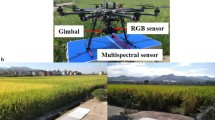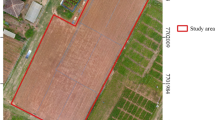Abstract
Biomass monitoring is one of the main pillars of precision farm management as it involves deeper knowledge about pest and weed status, soil quality, water stress, and yield prediction, among others. This research focuses on estimating crop biomass from high-resolution red, green, blue imaging obtained with an unmanned aerial vehicle. Onion, as one of the most cultivated vegetables, was studied for two seasons under non-controlled conditions in two commercial plots. Green canopy cover, crop height, and canopy volume (Vcanopy) were the predictor variables extracted from the geomatic products. Strong relationships were found between Vcanopy and dry leaf biomass and dry bulb biomass. Adjusted coefficient of determination (\({\text{R}}_{\text{adj}}^2\)) values were 0.76 and 0.95, respectively. Nevertheless, crop management practices and leaf depletion at vegetative stages significantly affect the accuracy of the canopy model. These results suggested that obtaining biomass using aerial images are a good alternative to other sensors and platforms as they have high spatial and temporal resolution to perform high-quality biomass monitoring.










Similar content being viewed by others
References
Agisoft LLC. (2011). Agisoft PhotoScan User Manual.
Allen, R. G., Pereira, L. S., Raes, D., & Smith, M. (1998). Crop Evapotranspiration (guidelines for computing crop water requirements). FAO Irrigation and Drainage Paper 56. Rome: FAO.
Andújar, D., Dorado, J., Fernández-Quintanilla, C., & Ribeiro, A. (2016). An approach to the use of depth cameras for weed volume estimation. Sensors. https://doi.org/10.3390/s16070972.
Ballesteros, R., Moreno, M. A., & Ortega, J. F. (2015a). Calibration and validation of thermal requirement models for characterizing phenological stages. Italian Journal of Agrometeorology-Rivista Italiana di Agrometeorologia, 3, 47–62. http://agrometeorologia.it/documenti/Rivista2015_3/calibration_and_validation_of_thermal_requirement_models_for_characterizing_phenological_stages.pdf.
Ballesteros, R., Ortega, J. F., Hernandez, D., & Moreno, M. A. (2015b). Characterization of Vitis vinifera L. canopy using unmanned aerial vehicle-based remote sensing and photogrammetry techniques. American Journal of Enology and Viticulture, 66(2), 120–129. https://doi.org/10.5344/ajev.2014.14070.
Ballesteros, R., Ortega, J. F., Hernández, D., & Moreno, M. A. (2014a). Applications of georeferenced high-resolution images obtained with unmanned aerial vehicles. Part I: Description of image acquisition and processing. Precision Agriculture, 15(6), 579–592. https://doi.org/10.1007/s11119-014-9355-8.
Ballesteros, R., Ortega, J. F., Hernández, D., & Moreno, M. A. (2014b). Applications of georeferenced high-resolution images obtained with unmanned aerial vehicles. Part II: Application to maize and onion crops of a semi-arid region in Spain. Precision Agriculture, 15, 593–614. https://doi.org/10.1007/s11119-014-9357-6.
Barker, D. J., Ferraro, F. P., Nave, R. G., Sulc, R. M., Lopes, F., & Albrecht, K. A. (2010). Analysis of herbage mass and herbage acumulation rate using Gompertzs equations. Agronomy Journal, 102(2), 849–857.
Bendig, J. V. (2015). Unmanned aerial vehicles (UAVs) for multi-temporal crop surface modelling- A new method for plant height and biomass estimation based on RGB-imaging. Retrieved from http://kups.ub.uni-koeln.de/6018/1/Bendig_PhD_2014_Ort&Datum_final_noCV.pdf.
Bendig, J., Bolten, A., Bennertz, S., Broscheit, J., Eichfuss, S., & Bareth, G. (2014). Estimating biomass of barley using crop surface models (CSMs) derived from UAV-based RGB imaging. Remote Sensing, 6(11), 10395–10412. https://doi.org/10.3390/rs61110395.
Bosch Serra, A. D., & Casanova, D. (1998). Estimation of onion (Allium cepa L.) biomass and light interception from reflectance measurements at field level. ISHS Acta Horticulturae, 519, 53–64. https://doi.org/10.17660/ActaHortic.2000.519.4.
Burgos, S., Mota, M., Noll, D., & Cannelle, B. (2015). Use of very high-resolution airborne images to analyse 3D canopy architecture of a vineyard. In International Archives of the Photogrammetry, Remote Sensing and Spatial Information Sciences: ISPRS Archives. https://doi.org/10.5194/isprsarchives-XL-3-W3-399-2015.
Chapman, S. C., Merz, T., Chan, A., Jackway, P., Hrabar, S., Dreccer, M. F., et al. (2014). Pheno-copter: A low-altitude, autonomous remote-sensing robotic helicopter for high-throughput field-based phenotyping. Agronomy, 4, 279–301. https://doi.org/10.3390/agronomy4020279.
Claverie, M., Demarez, V., Duchemin, B., Hagolle, O., Ducrot, D., Marais-Sicre, C., et al. (2012). Maize and sunflower biomass estimation in southwest France using high spatial and temporal resolution remote sensing data. Remote Sensing of Environment, 124, 844–857. https://doi.org/10.1016/j.rse.2012.04.005.
Corcoles, J. I., Ortega, J. F., Hernandez, D., & Moreno, M. A. (2013). Estimation of leaf area index in onion (Allium cepa L.) using an unmanned aerial vehicle. Biosystems Engineering, 115(1), 31–42.
ERGNSS. (2008). Spanish national GNSS reference stations network.
FAOSTAT. (2013). Agricultural statistical data of Food and Agricultural Organization of the United Nations. Retrieved December 21, 2015, from http://faostat3.fao.org/download/Q/QC/E.
Fonstad, M. J. (2012). Hyperspectral imagery in fluvial environments. In P. E. Carbonneau & H. Piégay (Eds.), Fluvial remote sensing for science and management (pp. 71–84). Chischester, UK: John Wiley & Sons, Ltd. https://doi.org/10.1002/9781119940791.ch4.
Gao, S., Niu, Z., Huang, N., & Hou, X. (2013). Estimating the leaf area index, height and biomass of maize using HJ-1 and RADARSAT-2. International Journal of Applied Earth Observation and Geoinformation, 24(1), 1–8. https://doi.org/10.1016/j.jag.2013.02.002.
Geipel, J., Link, J., Claupein, W., Lucieer, A., Zarco-Tejada, P. J., Rascher, U., et al. (2014). Combined spectral and spatial modeling of corn yield based on aerial images and crop surface models acquired with an unmanned aircraft system. Remote Sensing, 11, 10335–10355. https://doi.org/10.3390/rs61110335.
Gitelson, A., Peng, Y., Arkebauer, T. J., & Schepers, J. (2014). Relationships between gross primary production, green LAI, and canopy chlorophyll content in maize: Implications for remote sensing of primary production. Remote Sensing of Environment, 144, 65–72. https://doi.org/10.1016/j.rse.2014.01.004.
Gitelson, A., Viña, A., Arkebauer, T. J., Rundquist, D. C., Keydan, G., & Leavitt, B. (2003). Remote estimation of leaf area index and green leaf biomass in maize canopies. Geophysical Research Letters, 30(5), 4–7. https://doi.org/10.1029/2002GL016450.
Gupta, R. K., Prasad, T. S., & Vijayan, D. (2000). Relationship between LAI and NDVI for IRS LISS and LANDSAT TM bands. Advances in Space Research, 26(7), 1047–1050. https://doi.org/10.1016/S0273-1177(99)01115-1.
Hedley, C. (2015). The role of precision agriculture for improved nutrient management on farms. Journal of the Science of Food and Agriculture, 95(1), 12–19. https://doi.org/10.1002/jsfa.6734.
Hernández-López, D., Felipe-Garcia, B., González-Aguilera, D., & Arias-Pérez, B. (2013). An automatic approach to UAV flight planning and control for photogrammetric application. Photogrammetric Engineering & Remote Sensing, 79(1), 87–98.
Hofle, B. (2014). Radiometric correction of terrestrial LiDAR point cloud data for individual maize plant detection. IEEE Geoscience and Remote Sensing Letters, 11(1), 94–98. https://doi.org/10.1109/LGRS.2013.2247022.
Hunt, E. R., Cavigelli, M., Daughtry, C. S. T., McMurtrey, J. E., & Walthall, C. L. (2005). Evaluation of digital photography from model aircraft for remote sensing of crop biomass and nitrogen status. Precision Agriculture, 6, 359–378. https://doi.org/10.1007/s11119-005-2324-5.
Jannoura, R., Brinkmann, K., Uteau, D., Bruns, C., & Joergensen, R. G. (2015). Monitoring of crop biomass using true colour aerial photographs taken from a remote controlled hexacopter. Biosystems Engineering, 129, 341–351. https://doi.org/10.1016/j.biosystemseng.2014.11.007.
Lati, R. N., Filin, S., & Eizenberg, H. (2013). Estimating plant growth parameters using an energy minimization-based stereovision model. Computers and Electronics in Agriculture, 98, 260–271. https://doi.org/10.1016/j.compag.2013.07.012.
Li, W., Niu, Z., Huang, N., Wang, C., Gao, S., & Wu, C. (2015). Airborne LiDAR technique for estimating biomass components of maize: A case study in Zhangye City, Northwest China. Ecological Indicators, 57, 486–496. https://doi.org/10.1016/j.ecolind.2015.04.016.
Liu, J., Pattey, E., Miller, J. R., McNairn, H., Smith, A., & Hu, B. (2010). Estimating crop stresses, aboveground dry biomass and yield of corn using multi-temporal optical data combined with a radiation use efficiency model. Remote Sensing of Environment, 114(6), 1167–1177. https://doi.org/10.1016/j.rse.2010.01.004.
Lumme, J., Karjalainen, M., Kaartinen, H., Kukko, A., Hyyppä, J., Hyyppä, H., et al. (2008). Terrestrial laser scanning of agricultural crops. The International Archives of the Photogram metry, Remote Sensing and Spatial Information Sciences, 37(B5), 563–566.
Marino, S., & Alvino, A. (2015). Hyperspectral vegetation indices for predicting onion (Allium cepa L.) yield spatial variability. Computers and Electronics in Agriculture, 116, 109–117. https://doi.org/10.1016/j.compag.2015.06.014.
Meier, U. (2001). Growth stages of mono-and dicotyledonous plants. BBCH monograph. Braunschweig, Germany: Federal Biological Research Centre of Agriculture and Forest.
Moran, M. S., Inoue, Y., & Barnes, E. M. (1997). Opportunities and limitations for image-based remote sensing in precision crop management. Remote Sensing of Environment, 61(3), 319–346. https://doi.org/10.1016/S0034-4257(97)00045-X.
Ribeiro-Gomes, K., Hernandez-Lopez, D., Ballesteros, R., & Moreno, M. A. (2016). Approximate georeferencing and automatic blurred image detection to reduce the costs of UAV use in environmental and agricultural applications. Biosystems Engineering, 151, 308–327. https://doi.org/10.1016/j.biosystemseng.2016.09.014.
Sevacherian, V., Stern, V. M., & Mueller, A. J. (1977). Heat accumulation for timing Lygus control measures in a safflower-cotton complex. Journal of Economic Entomology, 70(4), 399–402. http://jee.oxfordjournals.org/content/70/4/399.abstract.
Steduto, P., Hsiao, T. C., Raes, D., & Fereres, E. (2009). AquaCrop—The FAO crop model to simulate yield response to water: I. Concepts and underlying principles. Agronomy Journal, 101(3), 426. https://doi.org/10.2134/agronj2008.0139s.
Swain, K. C., Thomson, S. J., & Jayasuriya, H. P. (2010). Adoption of an unmanned helicopter for low-altitude remote sensing to estimate yield and total biomass of a rice crop. Transactions of the ASABE, 53(1), 21–27.
Tilly, N., Hoffmeister, D., Cao, Q., Huang, S., Lenz-Wiedemann, V., Miao, Y., et al. (2014). Multitemporal crop surface models: Accurate plant height measurement and biomass estimation with terrestrial laser scanning in paddy rice. Journal of Applied Remote Sensing, 8(1), 83671. https://doi.org/10.1117/1.JRS.8.083671.
Torres-Sánchez, J., López-Granados, F., Serrano, N., Arquero, O., & Peña, J. M. (2015). High-throughput 3-D monitoring of agricultural-tree plantations with unmanned aerial vehicle (UAV) technology. PLoS ONE, 10(6), e0130479. https://doi.org/10.1371/journal.pone.0130479.
UNEP. (1997). In N. Middleton & D. Thomas (Eds.), World atlas of desertification (2nd ed.). London.
Usha, K., & Singh, B. (2013). Potential applications of remote sensing in horticulture-A review. Scientia Horticulturae, 153, 71–83. https://doi.org/10.1016/j.scienta.2013.01.008.
Zarco-Tejada, P. J., Diaz-Varela, R., Angileri, V., & Loudjani, P. (2014). Tree height quantification using very high resolution imagery acquired from an unmanned aerial vehicle (UAV) and automatic 3D photo-reconstruction methods. European Journal of Agronomy. https://doi.org/10.1016/j.eja.2014.01.004.
Acknowledgments
Authors would like to thank to National Government for funding AGL2014-59747-C2-1-R project and Regional Government of Castilla-La Mancha for funding PEII-2014-011-P project. We also wish to thank the Water User Association SORETA located in Tarazona de La Mancha, Albacete, Spain and the Irrigation Users’ Association of “Eastern Mancha” for their support of this work.
Author information
Authors and Affiliations
Corresponding author
Rights and permissions
About this article
Cite this article
Ballesteros, R., Ortega, J.F., Hernandez, D. et al. Onion biomass monitoring using UAV-based RGB imaging. Precision Agric 19, 840–857 (2018). https://doi.org/10.1007/s11119-018-9560-y
Published:
Issue Date:
DOI: https://doi.org/10.1007/s11119-018-9560-y




